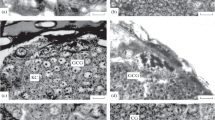Summary
The submicroscopic structure of nerve cells in the brain of the earthworm Eisenia was studied. Six types of neurons containing morphologically different inclusions are identified. Types 1, 2 and 3 contain vesicles filled with homogeneous materials of high electron density. These are essentially similar to “elementary granules” in neurosecretory systems of vertebrates and invertebrates. Type 4 shows dense-cored vesicles which resemble in size catechol-containing granules as described, for example, in chromaffin cells of the adrenal gland. Type 5 has clear vesicles with a mean diameter of 400 Å. Some of these vesicles have a dense osmium deposit. Type 6 contains electron lucent vesicles with diameters of 500–800 Å. Occasionally these have osmiophilic cores. Clear vesicles of types 5 and 6 are similar to classical synaptic vesicles, while “granulated vesicles” resemble in size and appearance those described in adrenergic nerve endings. All six vesicle types have the same mode of origin from Golgi membranes. All of these vesicles are considered to be discharged from the perikarya into the axons entering the neuropil.
Similar content being viewed by others
References
Afzelius, B. A., and G. Fridberg: The fine structure of the caudal neurosecretory system in Raia batis. Z. Zellforsch. 59, 289–308 (1963).
Bargmann, W., u. A. Knoop: Elektronenmikroskopische Beobachtungen an der Neurohypophyse. Z. Zellforsch. 46, 242–251 (1957).
u. A. Thiel: Elektronenmikroskopische Studie an der Neurohypophyse von Tropidonotus natrix (mit Berücksichtigung der Pars intermedia). Z.Zellforsch. 47, 114–126 (1957).
de Robertis, E.: Ultrastructure and function in some neurosecretory systems. Proc. Third Internat. Conf. on Neurosecretion. Memoir No 12, Soc. Endocr. p. 3–20 (1962).
, and S. H. Bennett: Ultrastructure of earthworm and frog synapses. Fed. Proc. 13, 35 (1954).
: Some features of the submicroscopic morphology of synapses in frog and earthworm. J. biophys. biochem. Cytol. 1, 47–58 (1955).
, and A. vaz Ferreira: Electron microscope study of the excretion of catechol-containing droplets in the adrenal medulla. Exp. Cell Res. 12, 568–574 (1957).
, and A. Pellegrino de Iraldi: A plurivesicular component in adrenergic nerve endings. Anat. Rec. 139, 299 (1961a).
: Plurivesicular secretory processes and nerve endings in the pineal gland of the rat. J. biophys. biochem. Cytol. 10, 361–372 (1961b).
, and D. Sabatini: Submicroscopic analysis of the secretory process in the adrenal medulla. Fed. Proc. 19 (Suppl.), 70–78 (1960).
Gordon, G. B., L. R. Miller, and K. G. Bensch: Fixation of tissue culture cells for ultrastructural cytochemistry. Exp. Cell Res. 31, 440–443 (1963).
Hagadorn, I. R., H. A. Bern, and R. S. Nishioka: The fine structure of the supraesophageal ganglion of the rhynchobdellid leech, Theromyzon rude, with special reference to neurosecretion. Z. Zellforsch. 58, 714–758 (1963).
Harms, J. W.: Über ein inkretorisches Cerebralorgan bei Lumbriciden sowie Beschreibung eines verwandten Organs bei drei neuen Lycastis-Arten. Arch. Entwickl.-Mech. Org. 143, 332–346 (1947–1949).
Honjin, R., A. Takahashi, S. Shimasaki, and H. Murayama: Two types of synaptic nerve processes in the ganglion of Auerbach's plexus of mice, as revealed by electron microscopy. J. Electronmicroscopy 14, 43–49 (1965).
Hubl, H.: Die inkretorischen Zellelemente im Gehirn der Lumbriciden. Arch. Entwickl.-Mech. Org. 146, 421–432 (1953).
: Ein neuer Typ neurosekretorischer Zellen im Unterschlundganglion der Regenwürmer. Naturwissenschaften 43, 284 (1956a).
: Über die Beziehungen der Neurosekretion zum Regenerationsgeschehen bei Lumbriciden nebst Beschreibung eines neuartigen neurosekretorischen Zelltypus im Unterschlundganglion. Arch. Entwickl.-Mech. Org. 149, 73–87 (1956b).
Kawabata, I.: Electron microscopy of the rat hypothalamic neurosecretory system. I. The supraoptic nuclei of normal and dehydrated rats. Gunma symposia Endoc. 1, 51–58 (1964).
Murakami, M.: Elektronenmikroskopische Untersuchungen der neurosekretorischen Zellen im Hypothalamus der Maus. Z. Zellforsch. 56, 277–299 (1962).
Oosaki, T., and S. Ishii: Observations on the ultrastructure of nerve cells in the brain of the planarian, Dugesia gonocephala. Z. Zellforsch. 66, 782–793 (1965).
Palay, S. L.: The fine structure of neurohypophysis. II. Ultrastructure and cellular chemistry of neuronal tissue. Edit. by S. Korey and J. I. Nurnberger, p. 31–49. New York: Hoeber-Harper 1957.
: The fine structure of secretory neurons in the preoptic nucleus of the gold fish (Carassius auratus). Anat. Rec. 138, 417–443 (1960).
Pellegrino de Iraldi, A., and E. de Robertis: Electronmicroscope study of a special neurosecretory neuron in the nerve cord of the earthworm. In: Electron microscopy. Proc. Vth Congr. Electron Microsc., vol. 2, p. U-7. New York: Academic Press 1962.
Reynolds, E. S.: The use of lead citrate at high pH as an electron opaque stain in electron microscopy. J. Cell Biol. 17, 209–212 (1963).
Richardson, K. C.: The fine structure of autonomie nerve endings of the rat vas deferens. J. Anat. (Lond.) 96, 427–442 (1962).
Rosenbluth, J.: The visceral ganglion of Aplysia californica. Z. Zellforsch. 60, 213–236 (1963).
Sano, Y., u. A. Knoop: Elektronenmikroskopische Untersuchungen am kaudalen neurosekretorischen System von Tinca vulgaris. Z. Zellforsch. 49, 464–492 (1959).
Scharrer, B.: Über „Drüsen-Nervenzellen“ im Gehirn von Nereis virens Sars. Zool. Anz. 113, 299–302 (1936).
: Über sekretorisch tätige Nervenzellen bei wirbellosen Tieren. Naturwissenschaften 25, 131–138 (1937).
Scharrer, E., and S. Brown: Neurosecretion. XII. The formation of neurosecretory granules in the earthworm Lumbricus terrestris L. Z. Zellforsch. 54, 530–540 (1961).
, u. B. Scharrer: Über Drüsen-Nervenzellen und neurosekretorische Organe bei Wirbellosen und Wirbeltieren. Biol. Rev. 12, 185–216 (1937).
Sjöstrand, F. S., u. R. Wetzstein: Elektronenmikroskopische Untersuchungen der phäochromen (chromaffinen) Granula in den Markzellen der Nebenniere. Experientia (Basel) 12, 196–199 (1956).
Takeuchi, N.: Neurosecretory elements in the central nervous system of the earthworm. Sci. Rep. Tohoku Univ., Ser. IV (Biol.) 31, 105–116 (1965).
Author information
Authors and Affiliations
Rights and permissions
About this article
Cite this article
Oosaki, T. Observations on the ultrastructure of nerve cells in the brain of the earthworm, Eisenia foetida, with special reference to neurosecretion. Zeitschrift für Zellforschung 72, 534–542 (1966). https://doi.org/10.1007/BF00319258
Received:
Issue Date:
DOI: https://doi.org/10.1007/BF00319258




